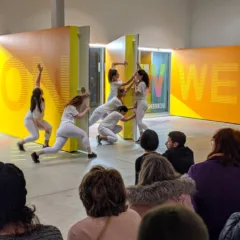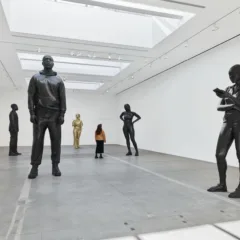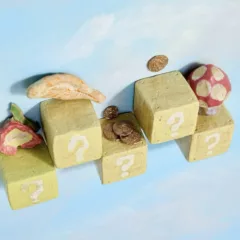
Reflections on Philadelphia: Then 1950-1980
by Dominique Ellis
I was dreading the six mile bike ride to the Globe Dye Works from Old City, but anxious to visit the space for the first time and to see the Philadelphia: Then and Now 1950-2019 exhibition put together by Helen Drutt, Matt Drutt and Bertrand Productions at this former factory space converted into one of the most spacious venues in the city. Luckily, I was able to catch a ride with Albert and Tina LeCoff on this rainy Saturday in October to view the exhibition before the crowds came.
Being born in 1980, I admittedly was less interested in my own generation, as much as the collection of crafts from Philadelphia: Then 1950-1980. Most of my 14 contemporaries in the Philadelphia: Now 1981-2019 section in the upstairs gallery I was familiar with and so I decided to visit it first and then revisit again before leaving that evening. I proceeded to go to the downstairs gallery where I spent most of the evening absorbing craft history through the objects, the artists present and the conversations around me.
Unfamiliar with both the textiles of Yvonne Palmer Bobrowicz and the ceramics of Rob Forbes, I could almost here Helen Drutt scold me for not knowing. It reminded me of my early days of working at The Clay Studio, as collector Vince Lim would challenge me each time he visited on the history of ceramics in the U.S. This is why we go to exhibitions though, to learn and grow and see the world through someone else’s vision. This room was a textbook of 40 names that every art student, artist and citizen should know.
Even after seven years of living in Philadelphia, I am still trying to catch up on my Craft History, as the regional names may not have the same weight in different parts of the U.S., even with the national and international success that these artists had. At the opening, meeting Yvonne Palmer Bobrowicz felt like meeting Anni or Joseph Albers or the first time I discovered Sheila Hicks. The entire evening of festivities was mirrored with these sort of moments, as I observed history without a textbook or being in a classroom.
Thinking critically about craft history, I recently asked Helen Drutt about her 1973 contemporary course on craft at the Philadelphia College of Art, the first in the nation to highlight this. I am intrigued by how one develops a syllabus and what the references are for the foundation of thought. Pioneers of Modern Design: From William Morris to Walter Gropius by Nikolaus Pevsner was one such reference. Originally published in 1936 under the title, Pioneers of the Modern Movement, by 1949 the Museum of Modern Art releases a second edition that is still produced today. This shift in emphasis from movement to design is important in relation to thinking about Philadelphia: Then.
One’s worldly perspective of 1950-1980 can be thought of mid-century to the trickle-down economics or the Pop Movement to Memphis Design. This moment of history after WWI, WWII and the Great Depression informs greatly this generation of makers whose training was also built on a foundation of drafting, industrial design, experimentation in multiple mediums and skill that only comes from countless hours of hard work in the studio.
One of the most iconic pieces in the room is Daniel Jackson’s “Rocking Unicorn” (1974) from the collection of Moderne Gallery. I never get tired of this majestic piece sculpted from wood, it is an image that stays in my mind due to its scale and the gesture of the form. The stories that Jackon’s widow, Julia Browne Jackson tells of this sculpture help contextualize how a child- sized version for their daughter was commissioned into the grandeur form that we see in the exhibition. Julia recently gave me a catalogue, Daniel Jackson: Dovetailing History of an exhibition held at the University of the Arts in 2003. The essay that Helen Drutt included for this show, Philadelphia in the Time of Jackson, speaks of 1964 and Philadelphia’s Craft Renaissance.
Perhaps this is why it is harder to see my own generation clearly, as we see the 30-50 years prior our moment in time with a different insight and perspective that only time and distance can provide. This period of 30 years exhibited was part of that Craft Renaissance that Helen spoke of, she also lived with. It was a moment where all the conditions were right and funding for the arts abundant and cost of living affordable. Many in the room downstairs had stable teaching jobs at points in their careers and there were different opportunities that each artist.
The exhibition catalogues reveal the importance of what no longer is taught in classrooms and is a record of some of the most insightful essays in the past century. For every Bobrowicz or Forbes that one generation doesn’t recognize, it goes the same for one not knowing Roberto Lugo or Mi- Kyoung Lee or those in the upstairs exhibition. As I slowly made my way back upstairs and in deep conversations with Lary Becker and Heidi Nivling, I knew that I needed to go back inside the Philadelphia: Now. It is craft expanded, free from the rigours of medium specificity and full of concepts that dig deeper than the medium itself. Both rooms have the highest levels of craftsmanship and skill, yet upstairs the innovation comes from reference to history and reinterpretation of past crafts.
Paying attention to then and now is paramount in a moment of time where we are saturated with images constantly on our phones. Witnessing both of these exhibition spaces and letting the history of craft in Philadelphia become a lived understanding of important moments in time opens up how I make sure to not too quickly walk past an object or installation. It is when we think we know what we are seeing before taking the time to absorb and contextualize that we are in danger as a society.
Bio
Dominique Ellis is a visual artist and writer who investigates global craft traditions, architecture, language and history. Currently she is the Retail Manager and Gallery Coordinator at The Clay Studio in Philadelphia, PA. Serving as a U.S. Peace Corps volunteer in Morocco from 2006-2008, she worked with the Moroccan Ministry of Handicrafts and Moroccan artisans in Small Business Development. In 2009-2010, she was awarded a U.S. Fulbright scholarship and Arabic language grant in Cairo, Egypt.
Social Media:
@dellisdesign (primary)
@thebeltdrivenyears (project based)
Websites:
http://www.dellisdesign.com (primary)
http://www.thebeltdrivenyears.com (project)








